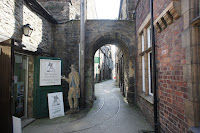A visit to the Georgian Theatre Royal in
Richmond, North Yorkshire, is a delightful, wondrous experience and akin to
stepping back in time. Theatres often burned down during the eighteenth century,
but this Georgian gem of a playhouse survived with most of its original
features intact.
 |
| Stage from pit (c) Cloud 9 Allen Tod |
|
In the eighteenth century, Richmond was an important
market town with a thriving provincial social scene, consisting of balls, race
meetings and Assemblies. But the town lacked a theatre as royal patents were
given to only a few provincial theatres. An Act was passed in 1788, allowing
licences for classical plays to be performed for sixty days at any one time, which enabled
Samuel Butler to open the Theatre in Friars Wynd in September that year. Butler
had married a twice-widowed, forty-six-year-old Richmond actress when he was
twenty-three in 1773 and took over the running of her troupe of travelling
players. The Butler Company continued to stage
regular productions until the lease expired in 1830. The Theatre closed in 1848
and became an auction house, wine store, and later, a corn chandler. Extensive
restorations over the years have ensured the Theatre retains its authenticity,
so audiences today enjoy the same intimate atmosphere as in past times.
 |
| The new front attached to original building (c) Cloud 9 |
|
In those days, patrons entered through the only
entrance, the double doors in Friars Wynd, and handed their coins to Mrs.
Butler in the pay box. The cheapest seats were in the gallery. For a shilling,
the young and dissolute climbed the narrow, wooden stairs and sat on the
benches. People in the front row would kick the board at the base of the panels
to indicate their disapproval of an actor's performance. The
original pay box and staircase are still there - the tight squeeze on the steep
stairs would have made exiting difficult and dangerous if a fire had occurred.

The pit cost two shillings and benches ran from
wall to wall. Today there are removable bench ends that extend over the aisles,
and detachable cushions and backs make the theatre experience more comfortable.
At three shillings per person, the boxes were the best seats. Or were they? While the crowd in the pit
could be hit by flying oranges and such, my guide informed me people sat for
four hours or more and had nowhere to relieve themselves, so the rich patrons
in the boxes sometimes ended up with wet wigs or clothing from urine dripping
through the floorboards overhead!
 |
| view from stage (c) Cloud 9 |
|
The
eleven boxes are named after playwrights. Only the inscription on the centre one,
Shakespeare, spelled the old-fashioned way, is original. The two boxes on the
edge of the stage allowed for intimate involvement between the audience and actors.
Juliet boxes, used for balcony scenes, are on either side of the stage above
the proscenium doors. The Royal Box is, of course, the best seat as it has a
direct line to the actors on stage. I
can confirm this is true after sitting on the same chair used by Prince Charles
and other royals. That's the closest I'll ever get to royalty! As I drank in the atmosphere and
admired the blue-green Georgian colour scheme, it was easy to imagine the
laughter from the pit, the actors raising their voices over the unruly crowd in
the gallery, the rustle of my silk gown as I turn to greet a friend in the next
box...oops, back to the present.
As there were no
tickets in those days, wealthier patrons would send their servants to pay
earlier in the evening and mind a seat for them. A peephole in the door to the
boxes slid open so they could see where their servants were sitting. Mrs.
Butler also used this to keep an eye on the performance and the audience's
behaviour. The ceiling has been painted with a blue sky and white clouds, imitating the open
courtyard where plays were watched before theatres were built. The Theatre
seats 214, but Samuel Butler could cram in 400 people.
The
floor of the stage was raised at the back to give audiences a better view. Candles
on dishes, floating in a trough of water, lit the foot of the stage. On chilly
evenings, the fireplace at the back of the stage was used to warm the actors. Both dressing rooms also have a fireplace. Actors often slept on the floor of
the dressing rooms when accommodation was unavailable during the busy Season. The machine room under the stage contained
the mechanism to winch the trough of footlights to the stage, and a counter-weighted
platform to shoot an actor through a trapdoor, which often resulted in injury.
Once there were three trapdoors, now there is one. The museum at the back of
the Theatre houses many original objects, as well as the Woodland Scene,
believed to be the oldest known scenery, painted between 1818 and 1836.
This video shows a detailed
tour inside the Theatre.
Here is the link to the Georgian Theatre Royal. Museum Week, held every summer, gives visitors an even greater insight into the Theatre's early beginnings.
Sources:
Curtis,
Vaughn, and Waugh, Doug, eds. The Georgian Theatre Royal.
Richmond: Castle Print








